You should care because SETI makes astrobiology and cosmology testable and evidence-driven: its searches — and even null results — refine where and how you look for life, constrain models like the Drake Equation, and prioritize exoplanets for biosignature follow-up. SETI spurs detector and algorithm advances, integrates biology, planetary science, and social perspectives, and turns absence into quantitative limits on habitability and technological lifetimes. Keep going and you’ll uncover how those limits, tools, and frameworks reshape our cosmic expectations.
Key Takeaways
- SETI tests hypotheses about life’s distribution by searching for technosignatures, refining where and how life might arise across the cosmos.
- Null results constrain models of technological civilizations, informing statistical limits on their frequency and lifetimes.
- Technosignature searches drive advances in detectors, signal processing, and multiwavelength observing vital to astrobiology.
- Comparing technosignature findings with planetary and atmospheric data improves target prioritization for biosignature searches.
- Considering detection ethics and governance integrates cultural, legal, and risk frameworks into astrobiology and cosmology research.
How SETI Shapes Our Understanding of Life’s Cosmic Distribution
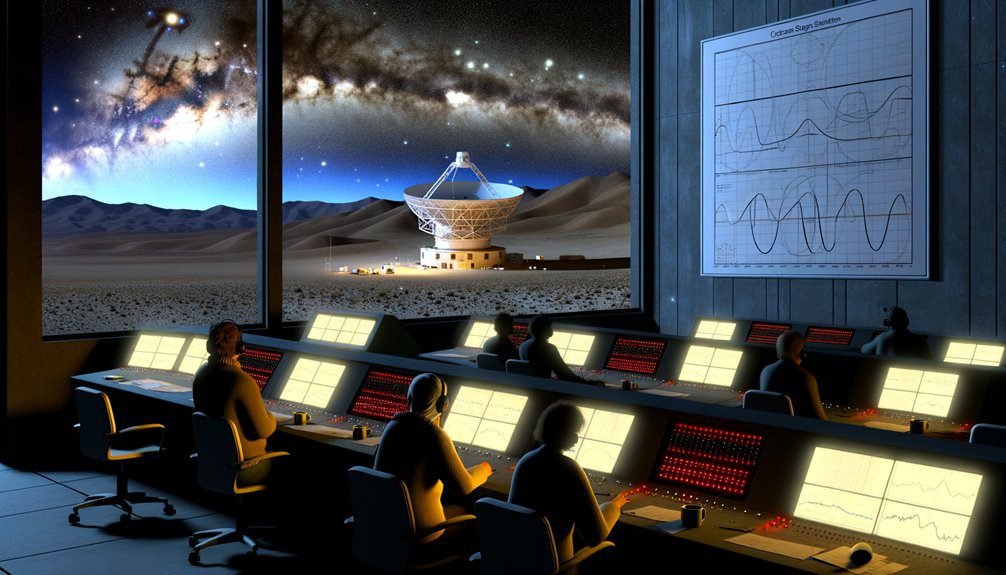
Because SETI doesn’t just hunt for signals, it reframes how you and scientists think about where life might arise and persist across the cosmos. You start to see life’s distribution not as a binary question but as a spectrum informed by astronomy, biology, and information theory. SETI prompts you to test hypotheses about habitable environments by searching for technosignatures across different stellar types, planetary systems, and epochs, so cosmic diversity becomes an empirical variable rather than an assumption. When null results accumulate, you refine models about energy use, longevity, and detectability; positive detections would force rapid empirical revision. This interdisciplinary approach ties observational surveys to laboratory studies of extremophiles, atmospheric modeling, and communication theory, sharpening priors about where to look next. You learn to weigh selection effects, instrument sensitivity, and theoretical plausibility together, making conclusions about life’s distribution more robust and actionable without leaping from suggestion to certainty.
SETI and the Refinement of the Drake Equation
While you might think of the Drake Equation as a fixed checklist, SETI has turned it into a living framework that’s continuously tested and revised by data, models, and cross-disciplinary insight. You’ll see how observational limits and null results constrain factors like the fraction of communicative civilizations and their longevity, forcing more realistic priors. Signal Sensitivity becomes a quantitative bridge: by specifying detection thresholds, bandwidths, and sky coverage, you translate survey outcomes into probability bounds for transmitter prevalence. You’ll also benefit from theoretical inputs — planetary demographics, atmospheric chemistry, and technological lifecycles — which reshape term correlations instead of treating them independently. Bayesian methods let you update the Drake Equation iteratively as new radio, optical, or technosignature data arrive, making uncertainty explicit and comparable across studies. In short, SETI converts the Drake Equation from a speculative product into an evidence-driven tool that guides where to look and how to interpret what you do or don’t detect.
Informing Exoplanet Prioritization for Biosignature Searches
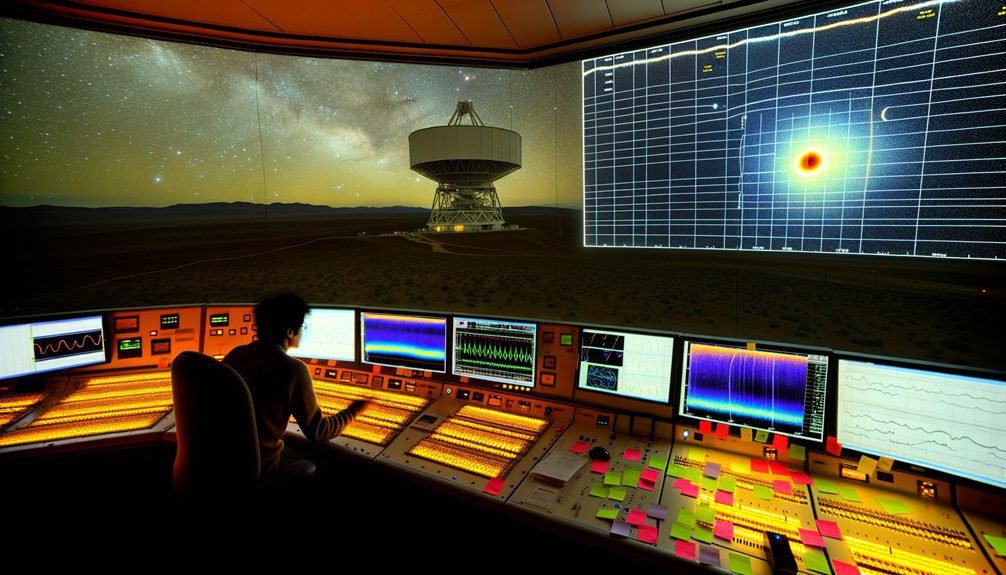
When you’re deciding which distant worlds deserve the limited time of flagship telescopes, SETI-driven thinking helps turn broad curiosity into concrete priorities: combine astrophysical observables (stellar age, activity, and planet size), atmospheric chemistry models, and the lessons from technosignature searches to rank targets by the plausibility and detectability of life. You’ll use exoplanet selection criteria that weigh not only habitable zone location but also observational accessibility and contextual likelihoods informed by SETI surveys. That means prioritizing planets where false positives for biosignatures are unlikely and where combined photometric, spectroscopic, and contextual data maximize interpretability. SETI contributes hypotheses about where complex life or technology might arise, which refines biosignature detection strategies to seek simultaneous, corroborating signals rather than isolated anomalies. By integrating demographic studies, stellar characterization, and targeted follow-up protocols, you make efficient, evidence-focused choices that raise the chances of a true biosignature discovery while minimizing wasted telescope time.
Technological Advances Driven by SETI Methods
As you compare techniques across radio, optical, and data science, you’ll see how SETI-driven signal processing breakthroughs sharpen sensitivity to faint, structured patterns. Those algorithmic advances pair with detector and antenna innovations—more efficient receivers, phased arrays, and cryogenic sensors—that expand the observable parameter space. Together they create testable, interdisciplinary tools you can apply to broader astrobiological searches and instrument design.
Signal Processing Breakthroughs
Because hunting faint, rare patterns across noisy data forced researchers to push algorithms farther, SETI-inspired signal processing has spun out breakthroughs you’ll now find in radio astronomy, telecommunications, and machine learning. You learn to apply signal analysis methods—matched filtering, spectral kurtosis, and transient detection—to extract weak, nonstationary signatures from interference-rich environments. Those same practices drive algorithm optimization for real-time pipelines, reducing false positives and computational cost while improving sensitivity. Cross-disciplinary teams validate methods on astrophysical pulsars, fiber links, and simulated extraterrestrial beacons, producing peer-reviewed metrics and open-source toolkits you can reuse. The result is a practical feedback loop: field challenges motivate new statistical tests and compression-aware inference, and rigorous evaluation standards accelerate adoption across science and industry.
Detector and Antenna Innovation
Signal-processing demands didn’t stop at algorithms; they reshaped the hardware you’d point at the sky. You see antenna designs evolve to support wideband searches, phased arrays, and low-noise feeds that boost detector sensitivity across frequencies. Interdisciplinary teams—engineers, astronomers, materials scientists—test novel surfaces, cryogenics, and digital backends with measured improvements.
| Innovation | Benefit | Evidence |
|---|---|---|
| Phased arrays | Beam steering, survey speed | Field tests show higher throughput |
| Low-noise amplifiers | Lower system temperature | Lab noise figures quantified |
| Cryogenic receivers | Enhanced sensitivity | SNR gains in observations |
| Broadband feeds | Wider spectral coverage | Successful multi-band campaigns |
| Digital correlators | Flexible processing | Detections enabled by real-time RFI rejection |
These advances make searches more sensitive, scalable, and reproducible.
SETI’s Role in Testing Models of Planetary Habitability
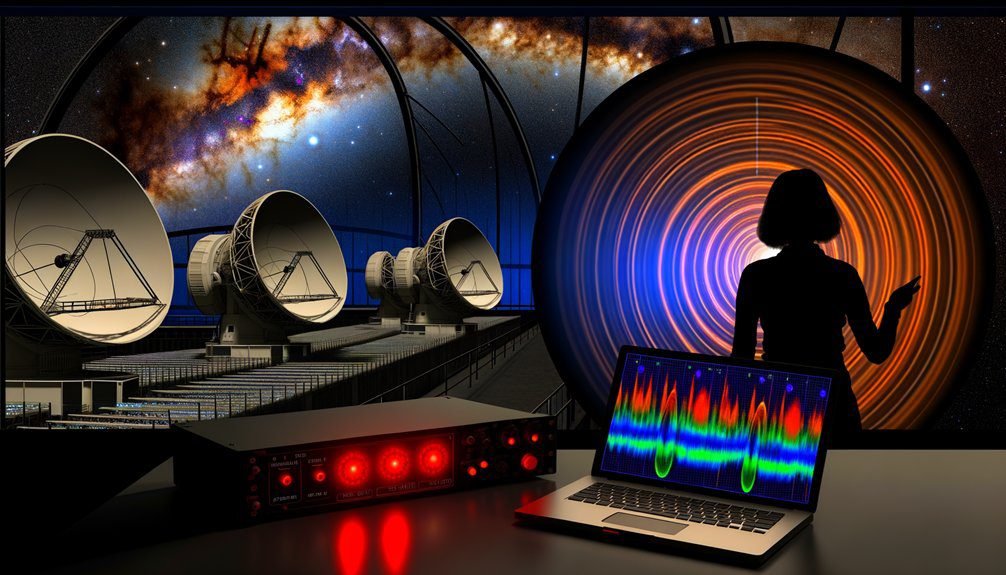
When you compare where technosignatures are—or aren’t—found with predictions from habitability models, SETI becomes a powerful empirical test bed for those models. You can use survey results to challenge planetary models and refine habitability criteria: are systems with Earth-like insolation and stable climates more likely to host technosignatures, or do unexpected environments dominate? By mapping detections and non-detections against stellar type, orbital dynamics, atmospheric composition and geological indicators, you test which variables actually matter. This approach is interdisciplinary—combining astronomy, geology, atmospheric science and anthropology—and evidence-focused: null results are as informative as positives when they constrain parameter space. You’ll iterate models, shifting priors about where life and technology could arise, and improve observational strategies. Ultimately, SETI gives you a feedback loop: theory suggests targets, observations validate or refute, and refined planetary models yield sharper habitability criteria for the next surveys.
Implications of Detection for Cosmological Perspectives
Linking empirical habitability tests to the question of detection naturally shifts us from local planet-scale models to the wider cosmological context: finding a technosignature would force you to rethink where intelligent life fits in cosmic history and structure. You’d have to place that signal within cosmic evolution, asking when and how often complexity emerged, whether intelligence is transient or persistent, and how technological activity ties to broader galactic processes. Evidence would prompt you to compare models of biosphere trajectories and extraterrestrial ecosystems, testing whether life follows convergent pathways or diverse strategies. Interdisciplinary data — from stellar demographics to planetary geology and evolutionary theory — would constrain rates, lifetimes, and distribution of intelligence across space-time. That reshapes priors in cosmology about observers, informs anthropic reasoning, and reframes questions about universal habitability. You’d gain empirical anchors for debates that were once philosophical, turning cosmological speculation into testable hypotheses about life’s role in the universe.
SETI Data and the Search for Technosignatures Beyond Radio
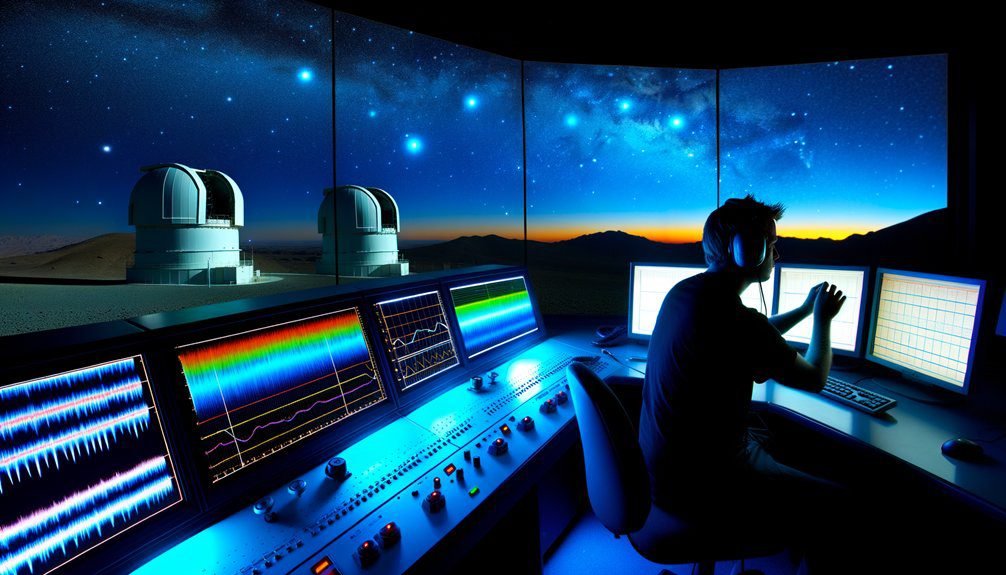
Although radio searches dominated early SETI, you’re more likely to find convincing technosignatures by widening the observational palette — optical, infrared, neutrino, gravitational-wave, and megastructure diagnostics each carry distinct physical footprints and discovery challenges. You’ll appreciate how technosignature diversity motivates varied search methodologies: transit anomalies, waste-heat spectra, laser pulses, neutrino bursts, and anomalous gravity-wave patterns all require different detectors, pipelines, and false-positive frameworks. Data fusion across wavelengths raises confidence and helps prioritize follow-up.
| Signal type | Key diagnostic |
|---|---|
| Optical | Pulsed/continuous lasers |
| Infrared | Excess thermal emission |
| Neutrino | High-energy bursts |
| Gravitational-wave | Non-astrophysical chirps |
| Transit/Megastructure | Irregular lightcurves |
You should evaluate candidates probabilistically, use cross-validation between instruments, and document null results to refine priors. That evidence-focused, interdisciplinary approach sharpens search methodologies and increases the chance of a robust technosignature claim.
Cross-disciplinary Impact: Biology, Anthropology, and Planetary Science
You’ll be surprised how principles like metabolism, information processing, and homeostasis can guide where and how we look for life across worlds, and they’ll force you to compare biology on Earth with alternative possibilities. You’ll also need to weigh how different cultures might interpret a signal or organism, using anthropological methods and historical evidence to anticipate social responses. Bringing in planetary science to constrain environments and chemical evidence will help you connect biological universals with realistic scenarios for contact.
Life’s Universal Principles
Because life on Earth shows recurring patterns—metabolism, information storage, replication, and adaptation—we can start to ask what principles might hold true elsewhere and how those principles shape questions in biology, anthropology, and planetary science. You’ll explore universal biology ideas: energy gradients, information fidelity, and selection as lenses that connect molecules to ecosystems and societies. Those concepts link to cosmic evolution, showing how chemistry and physics constrain possible life. You’ll ask testable hypotheses—what environments favor complex systems, how information architectures might differ, and what planetary contexts enable persistence. The table sketches key dimensions to compare.
| Dimension | Example |
|---|---|
| Energy use | Chemotrophy vs. photosynthesis |
| Information | DNA-like vs. alternative polymers |
| Adaptation | Rapid vs. slow evolutionary rates |
| Context | Planetary chemistry, climate |
Cultural Implications of Contact
When contact with extraterrestrial life becomes a plausible scenario, you’ll need to contemplate not just the biology but how that event would ripple through cultures, institutions, and planetary stewardship; anthropologists, biologists, and planetary scientists all bring evidence-based frameworks that can anticipate social reactions, ethical dilemmas, and policy choices. You’ll see cultural narratives shift as collective consciousness adapts, sparking existential reflections and religious reinterpretations grounded in comparative studies of belief change. Artistic expressions will process uncertainty and hope, offering qualitative data about meaning-making. You’ll consider societal evolution in governance, education, and risk management, informed by historical analogues and behavioral ecology. Global collaboration will be essential to coordinate science, policy, and equity, while technological optimism must be tempered by ethical oversight and empirical assessment.
Statistical Limits From Non-Detections and What They Mean
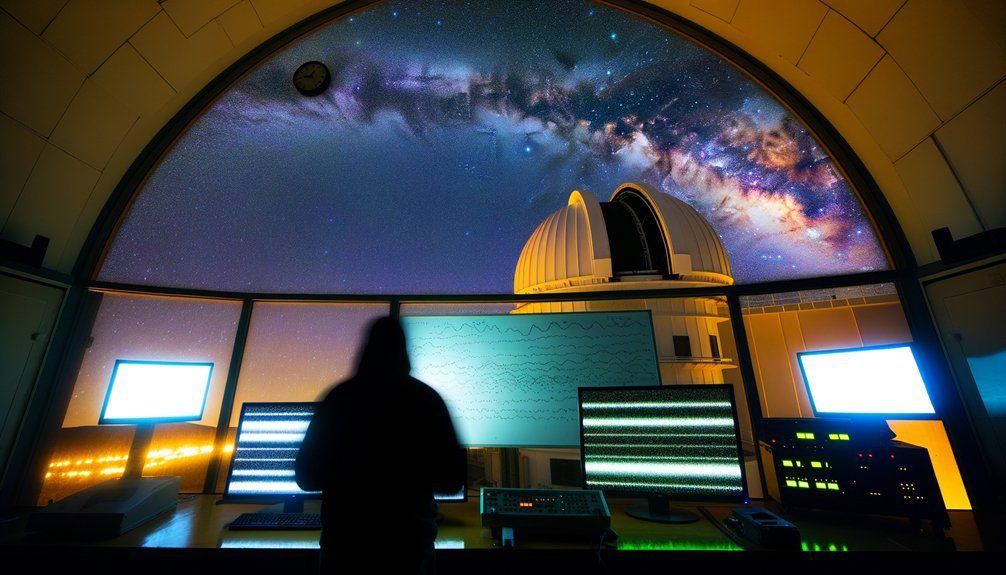
Although null results can feel like silence, they speak quantitatively: non-detections constrain the frequency and properties of phenomena we’re searching for, provided we carefully model our instruments, selection effects, and prior assumptions. When you analyze non detection implications, you translate absence into probabilistic limits—upper bounds on occurrence rates, luminosities, or technological lifetimes—using well-defined statistical thresholds like confidence intervals or Bayesian credible regions. You’ll combine survey sensitivity maps, noise characterization, and occurrence priors to avoid overinterpreting emptiness. Cross-disciplinary data—planet demographics, stellar activity, galactic structure—tighten those limits and highlight where searches were blind. Evidence-focused reporting means stating what parameter space is excluded and what remains open, so other researchers can refine strategies. Non-detections guide telescope allocation, signal-processing development, and theoretical plausibility, turning apparent null results into constructive constraints that sharpen hypotheses about life, its detectability, and where you should look next.
Ethical, Philosophical, and Policy Consequences of Contact
If you suddenly had credible evidence of another mind, you’d need to weigh our moral obligations to that intelligence alongside how contact would reshape religions, cultures, and identities. You’d also want interdisciplinary evidence to inform governance structures and risk-management strategies that minimize harm while protecting scientific inquiry. Those ethical, philosophical, and policy questions demand transparent, inclusive debate grounded in empirical assessment rather than speculation.
Responsibility to Other Minds
Because contact would confront us with minds unlike our own, we’ll need to rethink moral duties, legal frameworks, and scientific protocols all at once. You’d face questions about interstellar communication and ethical considerations: who speaks, who decides, and how you protect unfamiliar sentience. You’d balance scientific curiosity with duty of care, drawing on law, philosophy, and empirical risk assessment. Below is a compact framework to guide decisions.
| Area | Key question |
|---|---|
| Consent | How would you assess agency? |
| Harm mitigation | What counts as harm across minds? |
| Rights | Which protections apply? |
| Communication protocols | Who encodes messages and content? |
| Governance | Which institutions enforce norms? |
Cultural and Religious Impacts
Those who’d be charged with evaluating alien minds will also have to reckon with how contact reshapes cultures, faiths, and collective meaning; scientific protocols can’t be separated from the stories societies tell about their place in the universe. You’d examine how cultural narratives shift—whether artists, educators, and media frame contact as threat, blessing, or opportunity—and how those frames affect public understanding and policy preferences. You’d also track religious interpretations: theological leaders may integrate or resist evidence, prompting doctrinal debate and pastoral needs. Interdisciplinary research—history, sociology, theology, communications—gives evidence about past encounters with the unfamiliar and guides preparedness. By centering empirical study of meaning-making, you make space for dialogue that respects diverse worldviews while informing scientific communication and ethical reflection.
Governance and Risk Management
While contact would upend assumptions about agency and responsibility, we’ll need governance frameworks that blend ethics, risk science, law, and public values to steer decisions about communication, containment, and research priorities. You’d confront choices about transparency, who speaks for humanity, and how to weigh scientific curiosity against existential hazards. Interdisciplinary evidence — historical analogies, biosecurity models, and game-theoretic analyses — should inform your risk assessment and protocols for detection verification, sample handling, and messaging. Democratic deliberation and expert oversight must interact: legal instruments set boundaries, ethicists clarify obligations, and scientists quantify probabilities and consequences. By designing adaptive, evidence-based governance frameworks you’ll manage uncertainty, distribute responsibility, and keep options open while minimizing preventable harms.
Frequently Asked Questions
Could SETI Discoveries Reshape Religious Beliefs Worldwide?
Like a mirror held up to humanity, yes — discoveries could prompt widespread reevaluation. You’d see alien theology emerge as scholars, clergy and scientists debate meaning, and faith evolution would accelerate as traditions reinterpret texts and rituals. You’d witness interdisciplinary, evidence-focused inquiry temper sensationalism, while some people adapt beliefs, others double down, and new syncretic practices form. Overall, responses would vary culturally, guided by evidence and ongoing dialogue.
How Would SETI Findings Affect Global Economic Markets?
SETI findings could spark sharp, short-term market volatility as investors scramble to reprice tech, defense and resource sectors; you’d see increased SETI investments in research, communications and space infrastructure. You’d want to weigh interdisciplinary evidence — tech spin-offs, geopolitical responses, plus consumer sentiment — to gauge long-term effects. If credible, markets would gradually adapt, favoring firms that commercialize discoveries, while cautious policy and scientific vetting would temper speculative bubbles.
Who Owns Extraterrestrial Artifacts or Signals Legally?
No one currently owns extraterrestrial artifacts or signals outright under clear international law. You’d confront a patchwork: the Outer Space Treaty says space isn’t subject to national appropriation, so extraterrestrial ownership remains unresolved; national legal frameworks and new treaties would be needed. You’d look to interdisciplinary evidence, precedent in maritime/space law, and policy proposals to craft fair rules for extraterrestrial ownership, balancing scientific access, sovereignty concerns, and commercial interests.
Could SETI Results Be Weaponized by Governments or Organizations?
Yes — you could imagine a sealed war room where glowing data streams from ET contacts get repurposed as strategic advantage. You’d worry that SETI ethics would be sidelined without robust government transparency, letting signals be classified, manipulated, or weaponized. Curiosity-driven scientists and interdisciplinary policy-makers advocate evidence-focused protocols, open data, and legal norms to prevent misuse, balancing security concerns with transparent stewardship so discoveries inform humanity, not harm it.
What Psychological Impacts Might Contact Have on Children and Education?
You’d likely see heightened alien awareness and cosmic curiosity in classrooms, sparking new curricula and interdisciplinary learning. Kids might feel wonder, anxiety, or shifted identity; educators’ roles would include validating feelings, teaching critical thinking, and using evidence-focused resources to contextualize contact. Psychological impacts could include increased prosocial behavior or existential stress, so supportive counseling, age-tailored explanations, and research-informed pedagogy would help integrate curiosity with emotional resilience and scientific literacy.